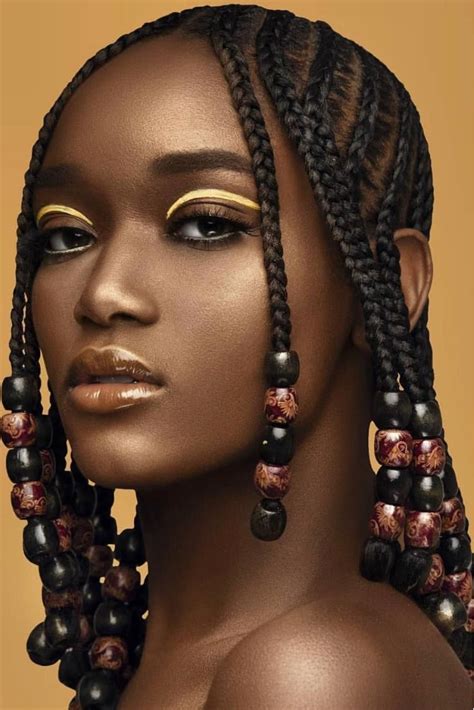Introduction: Celebrating the Tapestry of African Hair
Throughout history, natural black African hairstyles have served as a testament to the cultural diversity and rich heritage of the African continent. Each unique style carries its own story, embodying beauty, identity, and a deep connection to ancestral traditions. From intricately braided cornrows to volumized afros, these hairstyles have become a powerful symbol of empowerment and pride for black women and girls worldwide.

Section 1: The History and Evolution of Natural Black African Hairstyles
African hair is naturally textured and versatile, allowing for a vast array of hairstyles that have evolved over centuries. Archaeological evidence suggests that intricate beadwork and braiding techniques were already prevalent in ancient Egypt and Nubia. These hairstyles not only served as adornment but also held religious and social significance, indicating status, marital status, and group affiliation.
Over time, African hairstyles spread throughout the continent and beyond, influenced by cultural exchanges and the transatlantic slave trade. During the colonial era, black hairstyles were often suppressed or restricted, but the resilience and creativity of black women prevailed. The 1960s and 1970s witnessed a resurgence in natural hairstyles as part of the Black Power and Civil Rights movements, becoming a symbol of liberation and self-acceptance.
Section 2: Types of Natural Black African Hairstyles
The world of natural black African hairstyles is vast and diverse, offering endless possibilities for expression. Some of the most popular styles include:
- Cornrows: Intricate braids that are tightly woven close to the scalp, creating raised rows.
- Box Braids: Square-shaped braids that are thick and voluminous, offering longevity and versatility.
- Dreadlocks: Locs are formed when hair is twisted or matted together, creating long, rope-like strands.
- Afros: Volumized and natural, afros embrace the natural texture of black hair, showcasing its beauty and fullness.
- Twists: Hair is twisted into two or more strands, creating a defined and textured look.
Section 3: Benefits of Natural Black African Hairstyles
Embracing natural black African hairstyles offers numerous benefits, including:
- Protective: Braids, twists, and dreadlocks help protect hair from damage and breakage, promoting hair growth.
- Low-Maintenance: Many natural hairstyles require minimal styling and maintenance, making them convenient and time-saving.
- Versatile: Natural hairstyles can be styled in countless ways, allowing for a wide range of looks and versatility.
- Cultural Pride: Wearing natural hairstyles connects black women and girls to their cultural heritage, fostering a sense of pride and identity.
Section 4: Caring for Natural Black African Hair
Properly caring for natural black African hair is essential for maintaining its health and beauty. Here are some tips:
- Moisturize: Use products specifically designed for natural black hair to keep it hydrated and prevent dryness.
- Detangle: Use a wide-toothed comb or detangling brush to remove knots gently without breaking hair.
- Protect: Wear protective styles like braids or twists when sleeping or engaging in activities that can damage hair.
- Avoid Heat Styling: Limit the use of heat styling tools such as blow dryers and flat irons as they can weaken hair and lead to breakage.
Section 5: The Future of Natural Black African Hairstyles
The future of natural black African hairstyles looks bright, with increasing acceptance and appreciation for their beauty and cultural significance. Influencers, stylists, and celebrities are embracing these hairstyles, inspiring a new generation to explore their unique hair textures and styles.
Section 6: Tips and Tricks for Styling Natural Black African Hair
- Experiment with different braid patterns: Try various cornrow or box braid designs to create unique and eye-catching looks.
- Accessorize: Add beads, hairpins, or ribbons to braids and twists for a touch of embellishment.
- Embrace texture: Play up the natural texture of your hair by using products that define curls and coils.
- Don’t be afraid to experiment: Explore different styles and techniques to find what suits you best and expresses your personal aesthetic.
Section 7: FAQs about Natural Black African Hairstyles
Q: Are natural black African hairstyles difficult to maintain?
A: Many natural hairstyles require minimal maintenance, making them convenient and time-efficient.
Q: How can I prevent hair breakage when styling natural African hair?
A: Use products specifically designed for natural hair, moisturize regularly, and avoid excessive heat styling.
Q: What are some popular styles for natural black African hair?
A: Cornrows, box braids, afros, twists, and dreadlocks are among the most popular styles.
Q: How can I protect my natural hair when sleeping?
A: Wear a satin or silk bonnet or scarf to minimize friction and breakage while sleeping.
Section 8: Conclusion: Embracing the Beauty of Diversity
Natural black African hairstyles are more than just hairstyles; they are a celebration of cultural heritage, an expression of self-love, and a symbol of resilience and empowerment. Embrace the diversity and beauty of black hair in all its forms, and continue to explore the countless ways to celebrate your unique beauty.
